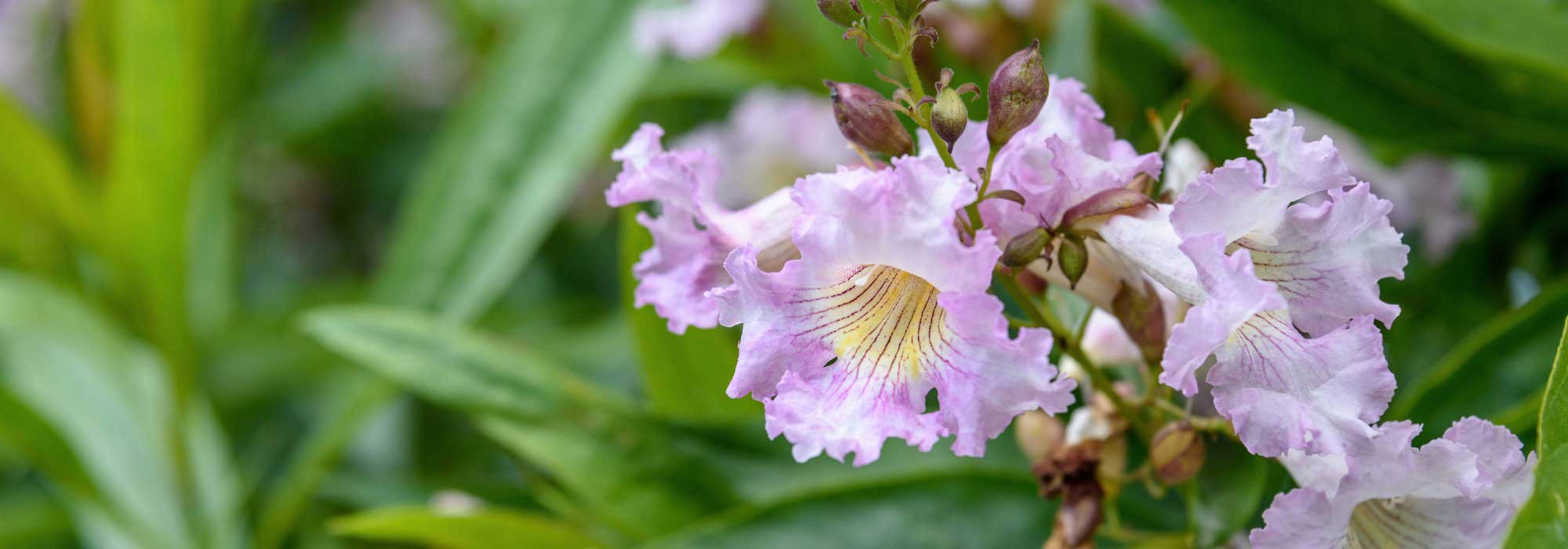
Chitalpa tashkentensis: planting, pruning, and care
Contents
The Chitalpa of Tashkent in a few words
- This is a small deciduous tree with exotic and rustic charm
- Highly floriferous, its abundant and fragrant trumpet-shaped flowers attract pollinators in summer
- Its foliage gives the tree a lush appearance, ideal for creating shade
- Hardy and drought-resistant, it is easy to grow in any well-drained soil
- Perfect for flowering hedges, as a standalone feature, or to shade the terrace
The word from our expert
The Chitalpa tashkentensis, a charming small tree, captivates with its abundant summer flowering, featuring tubular pink or white flowers. These are fragrant and melliferous, attracting bees and butterflies all summer long. With its lush foliage and airy habit, it provides light shade. Growing up to 10 metres in height, it boasts a lovely, natural-looking silhouette adorned with clusters of trumpet-shaped flowers. Deciduous and undemanding, it can be planted in many regions, adapting equally well to Mediterranean climates and less arid ones.
With good hardiness (down to -18°C), especially in well-drained soil, and drought-resistant, it thrives in all types of gardens: as a standalone specimen or grouped, in a mixed hedge with other bushes, in a grove, or even in a large container to shade a terrace for the more compact varieties. Easy to grow and versatile, it deserves a prime spot in your garden or on your terrace!
Botany
Botanical data
- Latin name Chitalpa tashkentensis
- Family Bignoniaceae
- Common name Chitalpa de Tashkent
- Flowering May to July, September
- Height 3 to 10 m
- Sun exposure Sun, partial shade
- Soil type well-drained, loose, deep, even calcareous
- Hardiness Down to -18°C
The Chitalpa, also known as Chitalpa de Tashkent, is a large bush or small deciduous tree from the Bignoniaceae family. It is a hybrid resulting from the cross-breeding between the Chilopsis linearis (desert willow) and the Catalpa bignonioides (Catalpa). It combines the characteristics of these two species, offering better drought tolerance than the Catalpa and more spectacular flowering than the Chilopsis. Native to the United States, the Chitalpa is mainly found in warm, dry regions, such as the southwestern coast and northern Mexico. It adapts well to Mediterranean climates in our country.
The genus Chitalpa includes only one recognised species, the Chitalpa tashkentensis, although specific cultivars have been developed to enhance certain traits such as flower colour or disease resistance, like ‘Pink Dawn’ and ‘Morning Cloud’, known for their abundant pink and white flowers respectively.
Its size generally ranges between 3 and 10 metres in height, with a spread of about 7 metres. Its form is upright with a rounded, often spreading crown, providing pleasant shade.
The foliage of the Chitalpa is deciduous, meaning it loses its leaves in winter. The leaves are single, lanceolate, and tapered, resembling a lance. They are olive-tinted green and measure between 10 and 20 cm in length, contributing to the lush appearance of the tree. This abundance of leaves gives the Chitalpa a dense yet airy silhouette, ideal for creating shade in a garden.
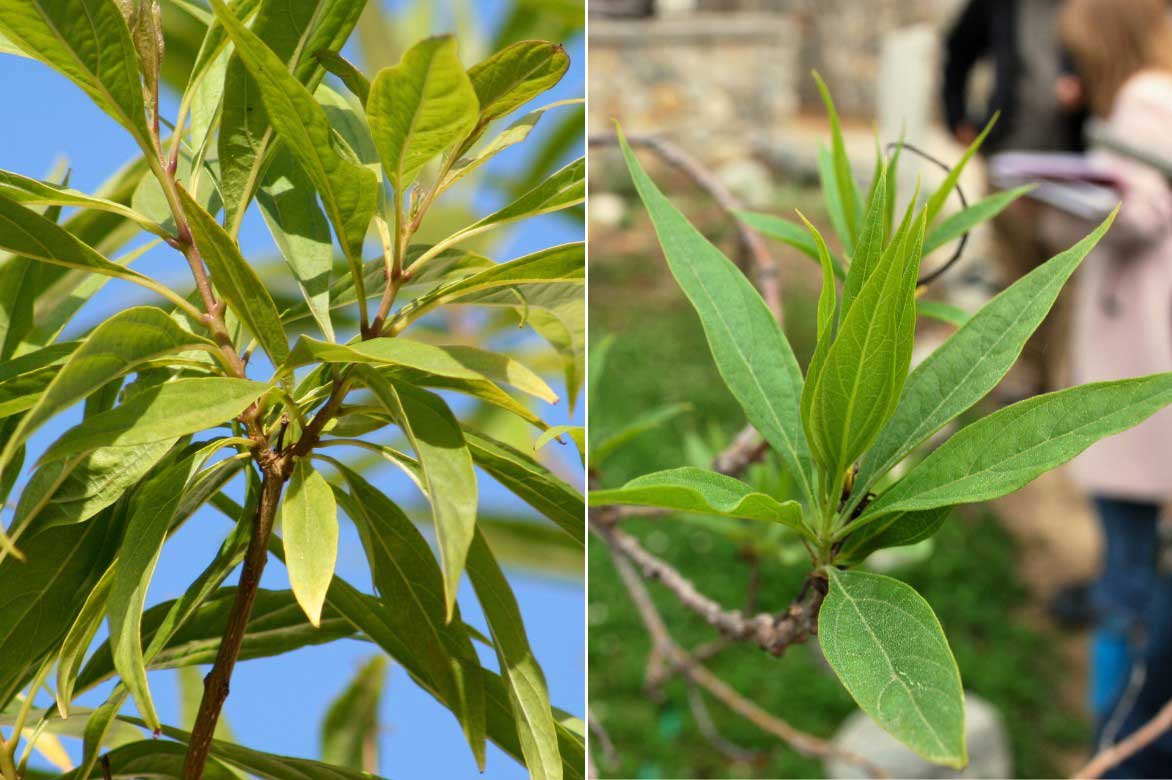
The foliage of the Chitalpa tashkentensis
In summer, the Chitalpa reveals its spectacular flowering. The tree is adorned with clusters of tubular pink or white flowers, which appear at the ends of the branches, from late spring to summer, typically from May to September depending on the climate. Under certain conditions, a second flowering may occur in September, extending the blooming period. The flowers of the Chitalpa are grouped in conical, upright racemes, appearing at the tips of the branches. They resemble those of the Catalpa, one of its botanical parents, in shape and arrangement. They are usually trumpet-shaped, with fused petals forming a tube at the base and opening into a corolla. They measure about 3 cm wide and have a tubular, campanulate form. They consist of five distinct lobes: three wider lobes at the lower part and two smaller ones with very undulate margins at the upper part. Their colour is mainly pale pink, often tinged with mauve, creating a subtle gradient of hues. The throat of the flowers is streaked with pale yellow and purple, adding a vivid contrast. Sterile, they do not produce seeds.
The flowering is abundant and long-lasting, continuing through summer, sometimes until the first frosts, and appreciated by many pollinators such as bees and butterflies, attracted by the nectar and sweet fragrance they exude.
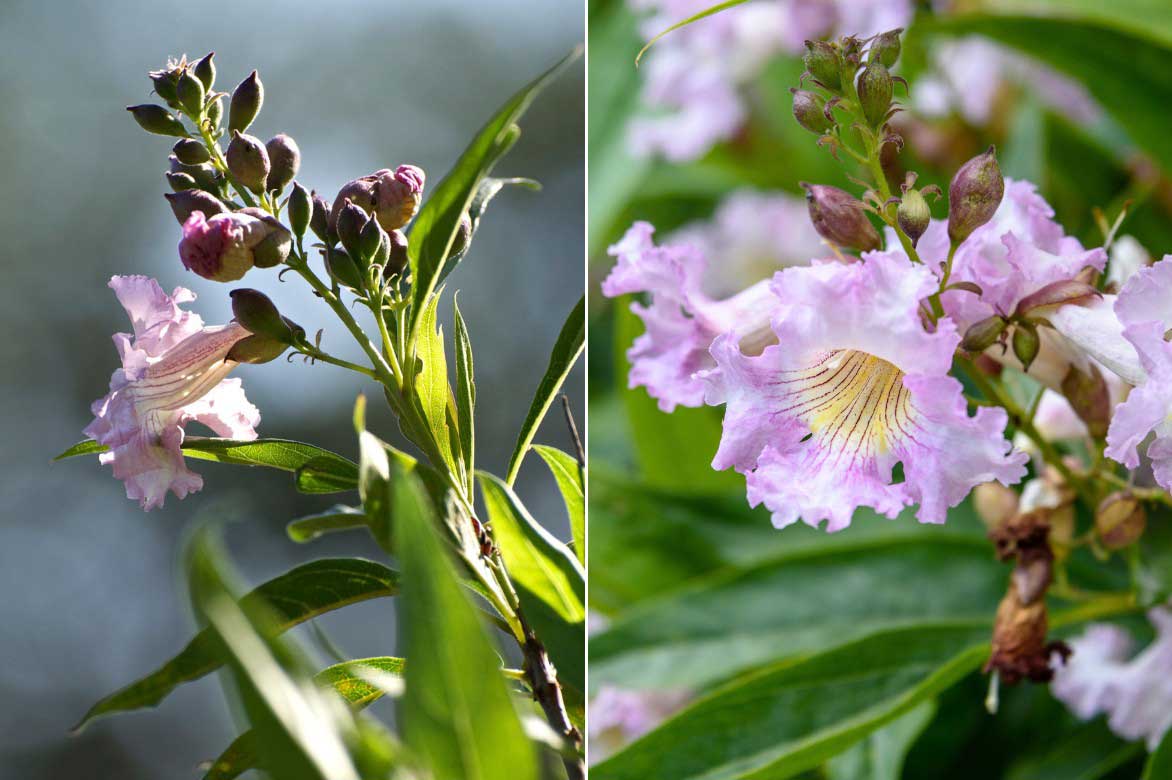
The Chitalpa offers beautiful soft pink flowers
Species and main varieties

x Chitalpa tashkentensis Summer Bells
- Blütezeit June to October
- Höhe bei Reife 3 m
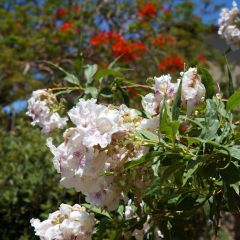
Chitalpa tashkentensis
- Blütezeit June to October
- Höhe bei Reife 5 m
Planting the Chitalpa
Where to Plant It?
Hardy down to -18°C and drought-resistant, the Chitalpa adapts well to any region. This beautiful ornamental tree thrives in any ordinary soil but prefers well-drained, loose, and deep soils, even those that are chalky. Once established, it withstands drought perfectly, making it ideal for regions with dry summers. To optimise its growth and flowering, it is best planted in full sun. In very hot climates, it can also be planted in light shade.
Its relatively fast growth and dense habit make it an excellent choice for creating free-flowering hedges or filling out the back of a border. Planted as a standalone, the Chitalpa can be used to shade a terrace. Thanks to its average height, typically between 5 and 10 metres, and its rounded, spreading crown, it provides pleasant shade during hot summer days. If grown as a coppice shoots, with multiple trunks, the Chitalpa offers a broad, bushy shape, ideal for large gardens or parks.
When to Plant It?
The ideal time to plant the Chitalpa is in spring, from March to May, or from September to November in milder regions. Prepare the soil by working it well to ensure good drainage.
How to Plant the Chitalpa?
In the Ground
- Start by loosening the soil deeply
- Soak the root ball in a bucket of water to moisten it thoroughly.
- Dig a hole twice as wide as the root ball
- Add drainage materials (gravel, coarse sand, etc.) if the soil is clayey
- Place the root ball in the hole, ensuring the collar of the tree is level with the ground
- Install a stake if needed to keep the tree upright
- Fill in with garden soil, mixed with a few spadefuls of garden sand, good compost, and compost
- Tamp down lightly
- Water generously after planting
- Spread a layer of mulch around the base to maintain moisture around the roots
- Continue to water regularly for the first two years

In a Pot
Smaller Chitalpas (such as ‘Summer Bells’) will make a stunning addition to a large pot on the terrace.
- Choose a container large enough, at least 65 cm in height
- Place clay pebbles or pumice at the bottom of the pot for drainage
- Plant the tree in a mix of soil, sand, and good compost
- Water at planting time, then regularly thereafter
- Repot every two years into a larger container
Pruning and Maintenance
Once well established, the Chitalpa requires no specific maintenance. Water-efficient, beyond the first two summers after planting, there is no need to water it, even in hot and dry climates. Simply add compost annually by scratching it into the soil at the base of the plant at the start of the growing season to encourage growth.
Easy to cultivate, this tree is resistant to diseases if provided with good growing conditions. In waterlogged or poorly drained soil, it may become susceptible to fungal diseases such as root rot, which causes the roots to decay.
How to Prune a Chitalpa?
The Chitalpa does not require specific pruning; it is only necessary, after flowering, to cut back dead branches or those that disrupt the bush’s habit. During the first few years, pruning in March to form a sturdy and well-balanced structure may be necessary. In summer, remember to remove spent flowers to encourage new flowering.
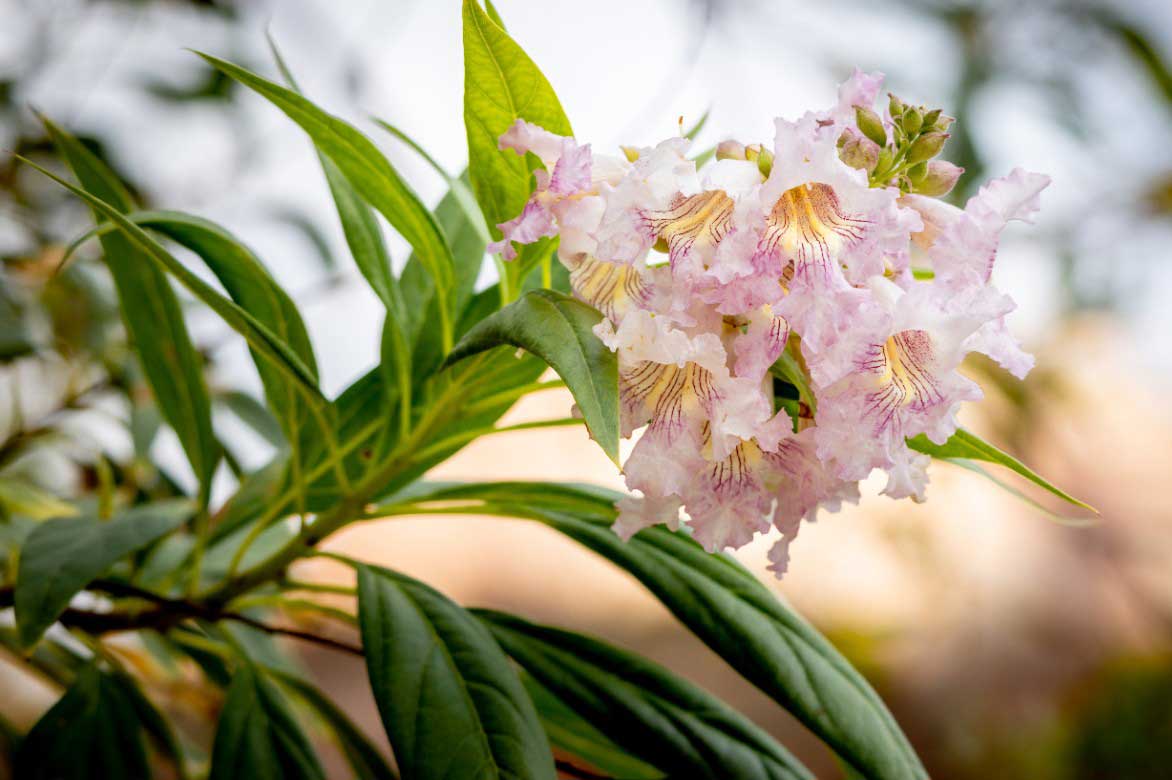
Multiplication
The propagation of Chitalpa is mainly done by propagation by cuttings, a quick and reliable method. Herbaceous cuttings, taken in summer or semi-woody in autumn, generally yield good results.
- Select a healthy and vigorous stem about 15 cm long
- Remove the leaves from the lower half of the stem and cut those on the top half in half
- Then plant the cutting in a mixture of compost and sand, kept moist
- Place the cutting under a cold frame, sheltered from direct sunlight
- After a few weeks, the roots should start to form
- Keep the substrate moist until rooting, which takes 1 to 3 months
- Once the cutting is well-rooted, it can be transplanted into a larger pot
- Plant your cuttings in the ground after one or two years of pot cultivation
Uses and associations
The Chitalpa tashkentensis is a versatile tree that can be integrated into the garden in various ways. With its slightly exotic yet rustic charm, it thrives almost anywhere in the garden, at the back of a perennial bed or in a loose hedge, near the terrace to provide shade.
It pairs perfectly in flowering hedges with ceanothus, buddleias, weigelias, hibiscus, viburnums, or lavateras, as well as with Japanese cherry trees, lilacs, and Chinese almond trees, which will flower before it. It creates a lush, flowering backdrop for bush roses. Pair the Chitalpa with evergreen shrubs, such as evergreen ceanothus in mild climates or boxwoods, which will take over when the Chitalpa sheds its leaves in winter. The light and airy appearance of ornamental grasses like miscanthus and stipas contrasts beautifully with the density of its foliage.
Its flowering will be particularly highlighted in a setting of silvery foliage, surrounded by artemisias, lavenders, and Festuca glauca. In a lush shrub bed, its delicate flowers will complement those of hydrangeas (in climates that aren’t too dry), yarrows, or the more delicate blooms of gaura and masterworts. The umbel-shaped flowers of agapanthus, whether purple or white, will add a touch of elegance and verticality, harmonising with the Chitalpa’s summer flowering.

Buddleia davidii ‘Pink Delight’, Chitalpa tashkentensis (photo: Wendy Cutler), Ceanothus delilianus ‘Gloire de Versailles’, Rose ‘Red Ballerina’
- Subscribe!
- Contents
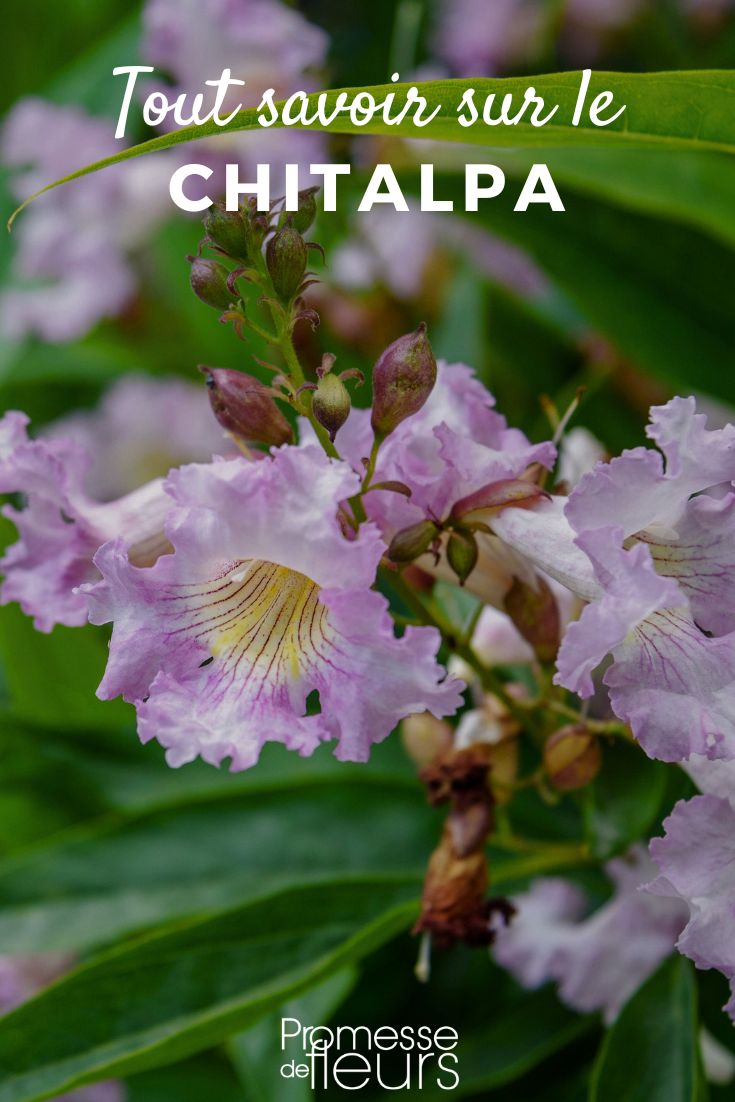































Comments